by Emma Knickelbine, Gathering Ground Intern 2021
As an ecocritic, it’s important to me to communicate ecocritical and scientific ideas in language that conveys the gravity of these traditionally academic concepts, and how they function in the daily lives of all of us. In my last post, I discussed entangled humanism as a way to feel connected to the food we eat, and also to the creatures that are intimately involved in that food’s existence. As I think about my time interning at Gathering Ground, another ecocritical theory comes to mind, one that is wrapped up in entangled humanism, yet takes it a step further. This is the recent discussion of trans-corporeality.
Trans-corporeality is a concept put forward by Stacy Alaimo in her 2010 book Bodily Natures (and picked up again in her 2016 book Exposed: Environmental Politics and Pleasures in Posthuman Times). Trans-corporeality is focused on physical bodies and the interactions between them. She points out that our lives as humans are filled to the brim with contact zones between our bodies and those of nonhumans – animals, plants, microbes, and anything that exists in our environment. Alaimo’s theory brings the focus onto these contact zones, the moments when humans interact with the nonhuman world. Once seen through the lens of trans-corporeality, every act of a human being can be seen to affect other bodies, and the body itself can be seen as a mobile space. Seeing the body this way, we become capable of acknowledging the unpredictable consequences of any number of human actions.
One of the easiest, and most potent, ways to see trans-corporeality at work is through a study of eating. Everyone eats, from humans down to the smallest microbes. And, in eating, we take the nonhuman into our bodies, where it becomes a part of us. Therefore, every body that eats or is eaten participates in a wild kind of alchemy, transforming from one existence to another through the act of consumption.

During one of our weekly internship seminars, we discussed the conventional method of growing potatoes, which includes heavy spraying of herbicides and pesticides. We heard an anecdote of a potato farmer who grew a separate patch of organic potatoes for his family to eat, because he couldn’t imagine feeding the conventional potatoes, with their piggyback load of toxins, to his own children. If we examine this situation through the lens of trans-corporeality, we add depth to this farmer’s choice – he knew how many chemicals were going onto those plants, and he couldn’t imagine those toxins also being knitted directly into the bodies of his growing children. Viewed this way, a lot of the food that we eat, whether washed or not, can be seen to bestow this secret heritage on our bodies, a heritage whose effects are barely known.
I’ve had a similar experience working at Folk Tree Farm as my second job on the island. I’ve seen the plants growing there, I’ve pruned, weeded, and planted, and at the end of a day of work I’m happy to eat a pea pod, a strawberry, a black currant. Those sugars, those nutrients sustain me in body and also in spirit – because I watched a small part of their growth for the season, and in a way, I grew with them. Through the food that we eat, our environment enters into our bodies, transcending the boundary our skin would seem to create. This is the fundamental truth of trans-corporeality – that while we believe our bodies to be separate, solid entities, they are indeed more pliable, prone to constant interaction with other bodies, whether we realize it or not.
Trans-corporeality brings a whole new dimension to the phrase “you are what you eat.” And I think it’s a positive, much needed realization as we decide exactly which foods we want to welcome into the ecosystems that are our bodies.




0 Comments